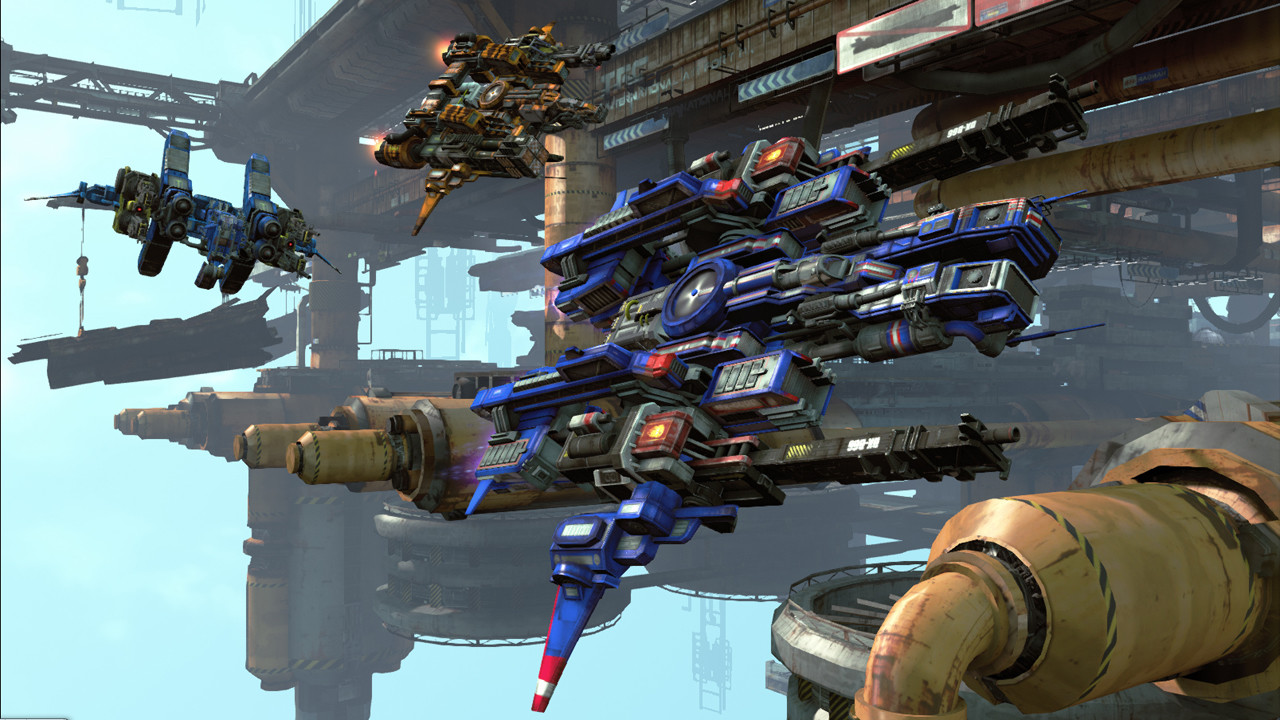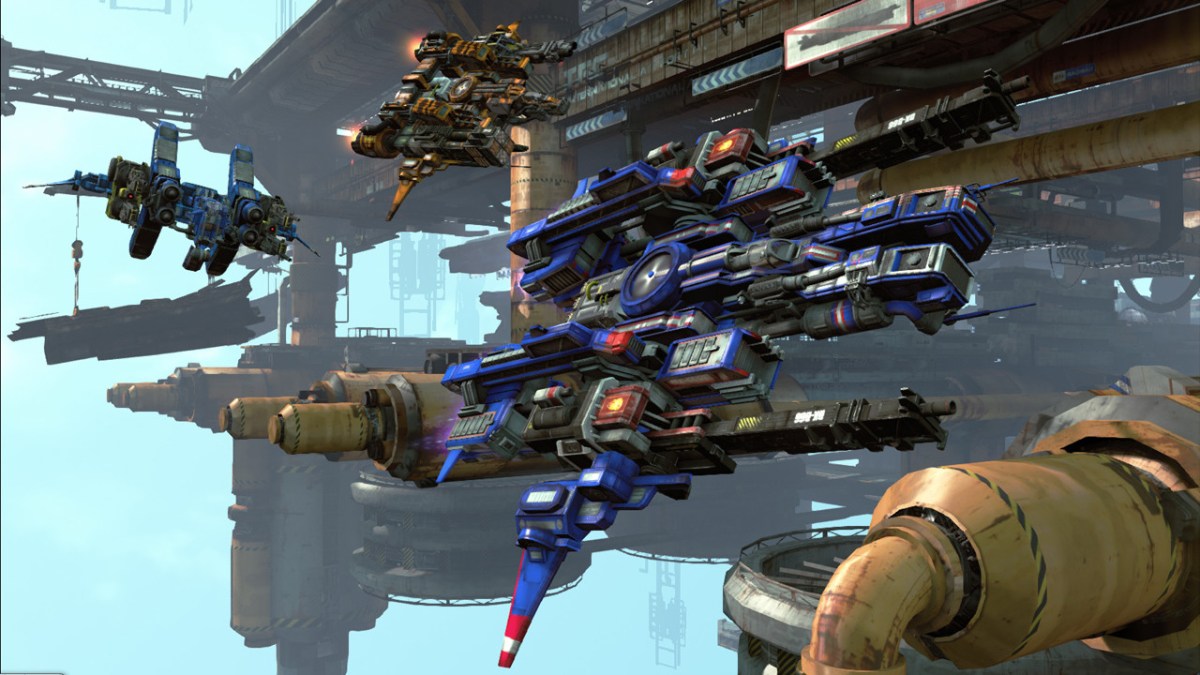Always fly with a wingman
Strike Vector was always a game I meant to check out on the PC. I heard good things about it when it was released back in 2014, and I’ve always had a soft spot for aerial shooters. But somehow I never quite got around to pulling the trigger.
With Strike Vector EX on the PS4, I finally had my second chance. A remaster of the original with a new single-player campaign, bot support for multiplayer, and a reworked UI, Strike Vector EX is a more complete package than what was released two years ago on PC. There’s never been a better time to jump in the cockpit and blow your friends out of the sky. But, even with that new campaign, loners might not find what they’re looking for.

Strike Vector EX (PlayStation 4)
Developer: Ragequit Corporation
Publisher: Ragequit Corporation
Released: August 30, 2016
MSRP: $14.99
All the action in Strike Vector EX takes place in the cockpit of a Vector, a sort of transforming plane/weapons platform. You can switch between a lightning-fast jet and an almost stationary hovercraft-mode (reminiscent of the Macross’ series Gerwalk-mode fighters) at the push of a button. The disparity between the two gives the game a very distinct, halting sense of movement that becomes quite enjoyable once you get used to it. There is just something fulfilling about going from a dead stop to a missile-dodging burst of speed in the blink of an eye, Isaac Newton be damned.
The level design makes great use of the Vector’s distinct modes. Missions and deathmatches take place above, below, around, and inside of mid-air mining facilities, cyberpunk cities, and ersatz S.H.I.E.L.D. hover carriers. Maps have lots of through-ways and wide open spaces to allow for crazy fast-paced jet combat, while still providing plenty of tight spaces to carefully thread through in hover-mode. While I constantly found the inability to properly roll the ship à la Ace Combat frustrating (the game auto-corrects you every time you roll above or below 180 degrees), there is still a great sense of risk and danger when trying to navigate these complicated spaces while engaged in a blistering dogfight.
In what struck me as a throwback to another age of deathmatching glory, there are power-ups and health kits scattered throughout the maps in both the single-player campaign and the multiplayer. Just like the ancient days of Quake 3, knowing where these resources are is essential for both your own survival, and for anticipating enemy movements and sending a psychically-guided rocket their way right before they can scoop up the health.
While the design might seem old-fashioned, it makes total sense the minute you realize how fragile and maneuverable the ships are. There needed to be a way of keeping the ships in action after getting dinged up in a dogfight and some way of making player movement at least somewhat predictable — pick-ups solve both problems nicely.
There are a number of ship options to tinker with and customize your Vector to suit your playstyle. A decent variety of main weapons are available (gatling guns, rockets, guided missiles, etc.) and each of them can be further customized with different perks that can boost damage, fire rate, reload speed, or whatever your personal flavor prefers. You also fly into battle with secondary items that range from mid-fight healing orbs and shields, to tesla coils that will encircle your plane in a ball of electricity and fry any enemies unfortunate enough to be close by. The final bit of customization is a passive bonus with options that include boosting your radar, making your plane trickier to track, or just slathering on some more armor.
While these options are much appreciated, I found the kit that worked for me fairly early and didn’t see much of a need to ever switch. I think most players will follow a similar route as some of the items and weapons just seem inarguably better than others. A round of balancing to bring some of the weaker options up to snuff would be appreciated.
Refreshingly, all of these options are available in multiplayer straight from the start, no progression grind or exhausting microtransactions in sight. There are skins, decals, and player icons that can be unlocked and purchased with in-game currency, but all the tools you need to play on a level footing with every other player are with you from the start.

Sadly, that brand new single-player campaign is almost entirely forgettable. The full mode can be completed in a brisk afternoon (I think it took me around three hours with a few coffee breaks tossed in here and there) and the story is barely worth paying attention to. The voice acting is limp and stilted in a way that I haven’t seen since the PS2 era and the story is a generic jumble of anime-dystopia. There are evil mega-corporations, ambiguous space pirates, and shady revolutionaries all trying to get one over on each other for reasons never fully established. Despite racing along with scant minutes (seconds in some cases) with each character, the plot springs a hilarious number of “shocking” twists on the audience. It’s hard to be blown away by a character’s sudden betrayal when you only met her two missions ago and didn’t even catch her first name.
There are challenge modes and online leaderboards to dip into, but none of that seemed compelling to me. Mainly, you’ll want to play the campaign to get a feel for piloting a Vector and to play around with different equipment before jumping online where the meat of the game seems to be.
The good news is, that meat is tasty and satisfying. The multiplayer in Strike Vector EX is excellent and likely where you’ll want to spend most of your time. Getting into dogfights with other human pilots whipping around in their Vectors is fast and thrilling in a way the AI pilots just can’t replicate. There are several modes to play ranging from the typical team-deathmatch and free-for-all options, to more exotic choices. I particularly enjoyed the Destruction gamemode which tasks teams with picking apart the opposition’s giant floating base while still being wary of enemy fighters, allowing for some great push-and-pull between the teams and ambush opportunities.
Strike Vector’s multiplayer reminds two of my favorite “hidden-gem multiplayer” games of the last generation, Space Marine and Transformers. Those games featured multiplayer add-ons to the main experience that didn’t exactly have a ton of depth (and would never see any kind of competitive scene), but were still weirdly enjoyable to hop into. They were both games I spent more time playing than I would have ever expected because there was just something breezy and enjoyable about their laid-back multiplayer experience. I can see myself coming back to Strike Vector EX for similar reasons.

You could say that’s a bit of a backhanded compliment seeing as how those games focused on the single-player campaign while the emphasis seems reversed in Strike Vector EX, but the sentiment remains. I don’t know how many people will get super into Strike Vector’s multiplayer and make a point of ranking up and getting all serious about it, but I can see it as a fun, low-stakes alternative when you’re sick of shooting people with M-16s in other multiplayer games.
Unfortunately, that lack of long-term interest is also my biggest worry about the game. Even only a few days after release I had trouble finding active lobbies with other players. While the game automatically adds bot pilots to matches in lieu of human players, that isn’t an ideal solution. It’s nice to have something to shoot at while waiting for real breathing players to join, but a worryingly large amount of my time in multiplayer was spent hanging around with half a dozen AI teammates with the occasional human dropping by now and then.
Strike Vector EX is a small game with a lot of heart. While the campaign is sub-par and it doesn’t offer the depth or longevity or other titles, what’s there is fun, fast, and wild. Released at a discount price, this is definitely a game to rope one or two friends into buying with you so you can always have a wingman (or nemesis) on call on and seed some multiplayer action.
[This review is based on a retail build of the game provided by the publisher.]





